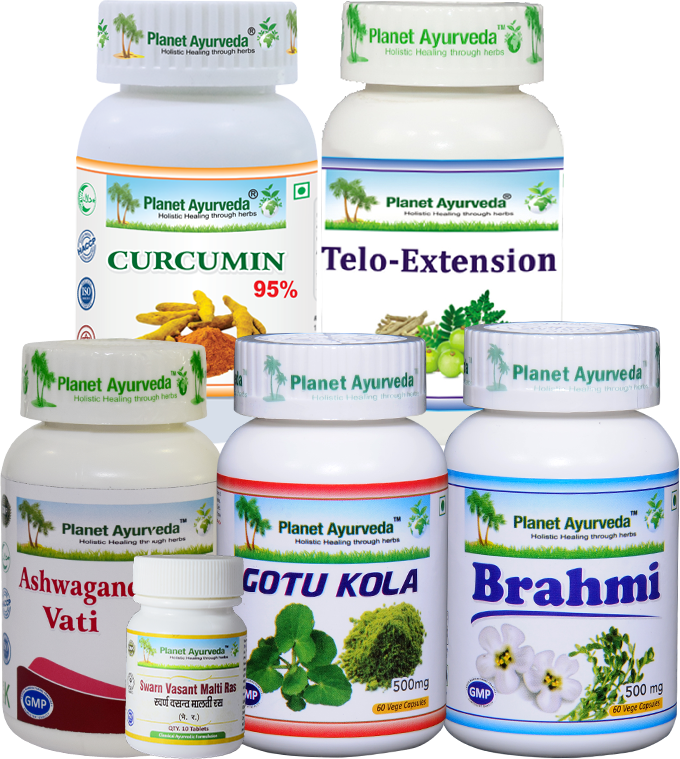WHAT IS ENCEPHALOMALACIA? – SYMPTOMS, CAUSES AND AYURVEDIC TREATMENT
ABSTRACT
Encephalomalacia is the softening or loss of the brain after cerebral infarction, cerebral ischemia, disease, brain injury, or other trauma. In short, this is a brain injury that affects neurons in the grey and white matter of the brain. It is also called Cerebral softening or Cerebromalacia. If left unchecked, it can affect other parts of the brain and damage its tissues. Some of these include the frontal, occipital, parietal, and temporal lobes. In this article, we discuss its causes, types, symptoms, radiological features, and Ayurvedic concepts.
INTRODUCTION
Encephalomalacia is a serious brain injury caused by the softening of brain tissue caused by trauma or inflammation. Encephalomalacia sometimes occurs in one part of the brain and then spreads to an adjacent area. As the brain changes due to tissue softening, the function of other organs in the body will also be affected. Therefore, encephalomalacia can cause other dysfunctions and diseases. This happens at any age. However, this disease is often fatal for babies diagnosed with it.

CAUSES
There are the following causes that are associated with Encephalomalacia:
- Stroke
- Ischemia
- Cerebral infarction
- Infection
- Abnormal collection of the blood
- Brain injury
- Craniocerebral trauma
- Haemorrhage
- Scar tissue
- Surgery
TYPES OF ENCEPHALOMALACIA
1. Polioencephalomalacia
This is the type of encephalomalacia that affects the gray matter of the brain and it affects the functions of the body like memory, speech coordination, muscle control, and emotions.
2. Leukoencephalomalacia
This is the type of encephalomalacia that affects the white matter of your brain. This area is responsible for sending nerve impulses to lower brain regions. In addition, this condition can be classified according to the development of encephalomalacia. The level of this progression can be determined by the colour of the damage level. They are as follows:
- Red Softening: It usually occurs in patients with hemorrhagic stroke in areas of the brain tissue that have turned red due to blood in areas that were not previously present.
- Yellow Softening: Often in injured people, the appearance of yellow nerves indicates plaque in the cerebral arteries.
- White Softening causes the brain area to have a white or yellow colour due to insufficient blood supply. This is often a sign of ischemic damage, indicating that the brain may be damaged or die.
SYMPTOMS
There are the following symptoms of Encephalomalacia:
- Extreme drowsiness
- Headache
- Sleep disturbance
- Vertigo
- Dizziness
- Mood changes
- Memory loss
- Decreased coordination
- Vision problems— temporary or permanent
- Dizziness
- Coma
RADIOGRAPHIC FEATURES
CT SCAN
- hypoattenuation, slightly higher CSF
- Loss of volume
- usually associated with gliosis and Wallerian degeneration
MRI
Monitor the CSF signal in all sections, including FLAIR.
- T1: low signal
- T2: high signal, high attenuating in FLAIR
- ADC: simple diffusion
TREATMENT OF ENCEPHALOMALACIA IN MODERN SCIENCE
Brain tissue is non-regenerative, meaning that once it’s gone, it’s gone forever because it can’t regenerate after damage. That’s why the brain is considered important. This makes mental health treatment an important factor in reducing or preventing further damage in the first place. Treatment includes:
- Stem cell therapy
- Identify the conditions that cause changes in brain tissue.
- Removal of brain tissue in severe cases. However, physical recovery cannot be guaranteed.
COMPLICATIONS
This is a serious disease. So, immediate action will be required. If this disease is left untreated, then various complications will occur, such as Coma, death, seizures, and functional disability.
PREVENTION
There is no such prevention method for encephalomalacia. However, these are some changes you can incorporate into your daily life.
- You can avoid serious head injuries by avoiding head blows.
- Monitor your health by following a healthy diet.
- Consume foods containing vitamin E.
AYURVEDIC OVERVIEW
In Ayurveda, we can associate Encephalomalacia’s symptoms with the vitiation of the three principal doshas: Vata, Pitta, and Kapha. This disease is caused by abhighataj, that is, injury to the body through whips, sticks, bricks, guns, fists, teeth, slaps, or the like. In this case, blood (Rakta vaha srotas dushti) causes pain, swelling, discoloration and anxiety. The Vata, Pitta, and Kapha doshas are the main sources from which all diseases arise because of their signs and symptoms. As we know, the whole world would not exist without Satva, Tamas, and Rajas. Similarly, without the Pitta, Kapha, and Vata doshas, there will be no diseases that occur in the human body. Vata, Pitta, and Kapha are found in the body and cause positive or negative effects on the body in good or bad times.
HERBAL REMEDIES FOR ENCEPHALOMALACIA BY PLANET AYURVEDA
Planet Ayurveda has made several herbal remedies for various ailments with various medicinal properties. All drugs are GMP-certified and safe for human consumption. The medicinal products used are pure, natural, and perfect. This medicine does not contain antibiotics, yeast, or additives and has no side effects. All products are vegetarian. Planet Ayurveda provides supportive Treatment for Encephalomalacia as described below:
PRODUCT LIST
- GOTU KOLA CAPSULES
- BRAHMI CAPSULES
- ASHWAGANDHAGHAN VATI
- CURCUMIN 95%
- TELO-EXTENSION
- SWARAN VASANT MALTI RAS
PRODUCT DESCRIPTION
1. GOTU KOLA CAPSULES
It is a single herbal capsule made from Gotu kola (Centella asiatica). The taste is bitter, which soothes Kapha and Pitta doshas. It contains antibacterial, antibacterial, antibacterial, antibacterial, antibacterial, antibacterial, antibacterial, and antibacterial drugs. kills the disease. It provides a good night’s sleep due to its calming properties. It has anti-ageing and rejuvenating properties. It increases the strength of the body.
Dosage: 2 Capsules, two times a day with plain water after food.
3. BRAHMI CAPSULES
It is a herbal medicine containing a single herb, Brahmi (Bacopa monnieri). It tastes bitter, and it calms all three doshas, especially Kapha and Vata. It contains antioxidants and can improve learning, memory, and thinking capacity. It is sedative, anticonvulsant, muscle relaxant, antipyretic, digestive, and carminative. Suitable for depression, anxiety, insomnia, high blood pressure, insanity, hysteria, and mental retardation. It is a good medicine for reducing stress and anxiety. It is also very effective in the treatment of anxiety disorders in hyperactive children and age-related autism in adults.
Dosage: 2 Capsules, two times daily, along with plain water.
3. ASHWAGANDHAGHAN VATI
It is a single herbal tablet containing Ashwagandha (Withania somnifera). Its taste is sweet, bitter, and astringent. Its effect is oily, warm, and mild. The drugs are called bale (tonic), rasayan (rejuvenating), and atishukrala (enhances spermatogenesis). A great tonic for the brain and nervous system. It has anti-inflammatory, analgesic, diuretic, mild sedative, and aphrodisiac properties. Regulates hormones and the immune system. It is suitable for many diseases such as weight loss, arthritis, insomnia, high blood pressure, and back pain. It increases alertness, prevents various types of fatigue, and increases physical strength and energy. It is beneficial for fatigue. It helps promote good sleep and reduces joint aches.
Dosage: 2 Tablets twice daily with lukewarm water.
4. CURCUMIN 95% CAPSULES
It is a single herbal capsule containing Curcuma longa (Haridra). It tastes bitter. Calms Vata and Kapha. It has digestive, astringent, anti-diabetic, and blood-forming properties. This drug is very good for the skin. It contains protein, vitamin A, carbohydrates, and minerals. It has antibacterial, antiallergic, diuretic, antioxidant, and carminative effects. It is good for burns, liver disease, spots, and acne. Inhibits skin and tumours. It is an excellent antibiotic.
Dosage: 1 Capsule twice daily along with plain water after food.
5. TELO-EXTENSION
These are various herbs made from Ashwagandha (Withania somnifera), Amla (Emblica officinalis), Giloy (Tinospora cordifolia), and others. It calms all three doshas: Vata, Pitta, and Kapha. It helps prevent disease and premature signs of ageing. It is an excellent antipyretic, astringent, antacid, diuretic, laxative, and hemostatic. It also acts as a support for all physiological diseases of the body. Suitable for diabetes, oedema, cough, jaundice, eye problems, weight loss, leukorrhea, asthma, fever, hyperacidity, peptic ulcer, and gastrointestinal diseases. Effective for recurrent UTIs. It is a good antioxidant and is also beneficial for many chronic diseases and waste.
Dosage: 2 Capsules twice daily.
6. SWARAN VASANT MALTI RAS
It is a classic Ayurvedic treatment made from Swarna bhasma (Gold calx), Mukta bhasma, Trikatu (black pepper, long pepper, and dried ginger), Loha bhasma (Iron bhasma), and more. It calms Vata and Kapha but warns Pitta. It is a powerful stimulant for the digestive and respiratory systems. It has carminative, antipyretic, diuretic, aphrodisiac, and immunostimulating properties. It clears the sinuses and helps with many respiratory problems, such as cramps, infections, and allergies. It is suitable for loss of appetite, haemorrhoids, and constipation, and it improves spleen and liver functions. It increases blood flow in the body.
Dosage: 1 Tablet twice daily with honey.
Conclusion
In this article, we learn about encephalomalacia, a softening of the brain. In Ayurveda, we can attribute this illness to the failure of the doshas (Vata, Pitta, and Kapha), the trinity of body energy, due to abhighata (meaning injury). There is no cure for this disease. Patients are supported based on their symptoms and severity only, and all three doses are balanced to delay infection. To get rid of these symptoms, take a proper dose of medicine from Planet Ayurveda.
Dr. Vikram Chauhan
Latest posts by Dr. Vikram Chauhan (see all)
- ALTERNATIVE AYURVEDIC TREATMENT FOR CHRONIC KIDNEY DISEASE - July 24, 2024
- Ayurvedic Treatment for Liver Disease with Herbal Remedies - July 22, 2024
- Ayurvedic Treatment For Diabetes Mellitus With Herbal Remedies - July 4, 2024
- Ayurvedic Aspect Of Liver And Management Of Liver Diseases - July 3, 2024
- Natural Ayurvedic Treatment For Fibromyalgia With Herbal Remedies - July 2, 2024






